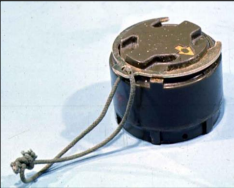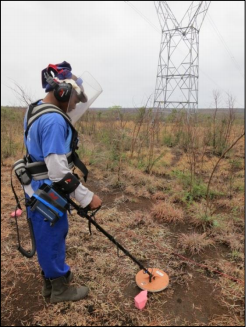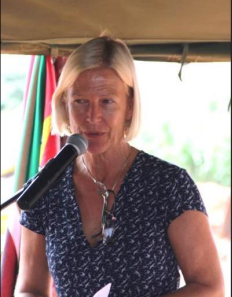
Even after 25 years of humanitarian mine clearance, the HALO Trust continues to face new challenges as it works on some of the world’s most difficult minefields. When confronted with a new technical challenge, HALO leverages not only its own experience, but also its network of technical experts and committed donors to find a solution. Such was the case when HALO encountered minimum metal anti-personnel mines under the Gumbane power lines in Mozambique. It was with support from Sweden and Minelab technology, that HALO was able to adopt an innovative solution.
Right: Funding from the Swedish Ministry for Foreign Affairs allowed HALO to purchase three Minelab GPX 5000 detectors to find M14 mines on the Gumbane power line in Mozambique. (Photo credit: Brent Stirton)
The Gumbane power line, which is the largest of the power lines that feeds Mozambique’s capital Maputo, consists of 201 towers running from Maputo to the town of Ressano Garcia on the border with South Africa. Each tower is spaced about 300m apart and the entire line is approximately 80km in length. The power line was mined during the Mozambican Civil War when government forces used anti-personnel mines to defend key pieces of infrastructure from sabotage. Around each tower, mines such as PMD-6, PMN, PMN 2, and the POMZ and OZM series were laid to prevent saboteurs from accessing and placing explosive charges on tower support legs. A number of military positions and observation posts, which were also defensively mined, were established nearby to further protect the power lines.
After the war, the mines inhibited reconstruction and repairs by preventing safe access to the towers by the national electric company, Electricidade de Moçambique (EDM). There were accidents in the past when EDM workers tried to access the power line. Silvio Gemo, EDM Technical Director, remembers a number of occasions when workers detonated mines when trying to make repairs. The mines also caused civilian and livestock accidents. Many living in proximity to the towers, cultivating land and grazing livestock beside the towers were endangered. The completion of clearance of the power line, as a critical piece of national infrastructure powering the capital, was of the very highest priority for the Government of Mozambique.
During HALO’s clearance operations a new technical challenge was encountered on discovery of M14 mines at towers at the northern end of the line, close to Ressano Garcia. These mines contain a very small amount of metal which can make them difficult to detect with conventional metal detectors. Adding to the difficulty in their detection were two other factors, unique to the locality, namely that these mines were laid in mineralised soil, and that the overhead power lines of the towers created electro-magnetic interference.
Right: An M14 mine as found on the Gumbane power line. The mine has a small amount of  metal which can make it difficult to detect with conventional metal detectors. (Photo credit: The Collaborative Ordnance Data Repository1 )
metal which can make it difficult to detect with conventional metal detectors. (Photo credit: The Collaborative Ordnance Data Repository1 )
This combination of factors meant that HALO’s existing detectors were unable to find the M14 mines to the depth required by Mozambique’s national standards for mineclearance. It was the electromagnetic interference, in particular, that proved highly problematic for HALO’s existing detectors. As such, a new technical solution to this challenge was needed.
In July 2013, HALO began consultation with the Australian detector company, Minelab. Their counter-mine division suggested that the GPX 5000 commercial gold detector might be the solution given its ability to be programmed for a very broad range of conditions. In August 2013, a Minelab consultant performed a test demonstration of the GPX 5000 at the Gumbane Power Line using a rendered safe M14 as a target.
 Left: A GPX 5000 at work on the power line. (Photo credit: the HALO Trust).
Left: A GPX 5000 at work on the power line. (Photo credit: the HALO Trust).
The detector performed well, prompting HALO to continue testing the unit through October at which point the decision was made to purchase three for use on the power line. Despite the outlay, it was calculated that it would be more cost effective to purchase and use the GPX 5000 detectors than to clear the towers mechanically, which was an alternative but less attractive technical solution being considered. It was thanks to Swedish funding that HALO was able to purchase these detectors and begin safely and efficiently clearing all towers with a suspected M14 threat.
All three GPX 5000 detectors were deployed operationally in October 2013 and by the time clearance finished in February 2014, 220 M14 mines had been found by HALO on six different towers using these detectors. This was the first time globally that the GPX 5000 detector had been used for mineclearance. The GPX 5000 proved to be an effective and innovative solution to a unique problem.
Minelab’s Hugh Graham, General Manager of its Counter-mine division supported the pioneering use of the detectors stating: “HALO Trust’s constant use of innovation to improve safety and mine field clearance rates has challenged Minelab to provide ongoing detection solutions. In this instance combined experience and cooperation between HALO and Minelab enabled a timely solution to a specific detection problem. HALO’s willingness to seek solutions to problems rather than accept the status quo clearly contributes to its commitment of “Getting Mines Out of the Ground, For Good”. Minelab takes great pleasure in its cooperation with HALO Trust and is extremely proud to be able to contribute to HALO’s vitally important work”
In March 2014 the government of Mozambique declared Maputo Province free of all known minefields. This great accomplishment was made possible by the completion of the Gumbane power line which was the last remaining minefield in the province and of great significance to the government and the people of Mozambique.
Right: Her Excellency Ms. Ulla Andrén, Swedish Ambassador to Mozambique speaks at a  ceremony held in Maputo in March 2014 to mark the completion of mineclearance in the province and with that, the Gumbane power line. (Photo credit: the HALO Trust)
ceremony held in Maputo in March 2014 to mark the completion of mineclearance in the province and with that, the Gumbane power line. (Photo credit: the HALO Trust)
Silvio Gemo from EDM knows the benefits clearance of the power line brings: “now we can conduct our maintenance free from the fear of mines, and start the installation of a new electricity line”.
The identification of a solution to the M14 mine threat on the Gumbane power line would not have been possible without the financial support HALO received from Sweden’s Ministry for Foreign Affairs and the technical support received from Minelab.
The HALO Trust extends its gratitude to the Kingdom of Sweden for its support to mine action